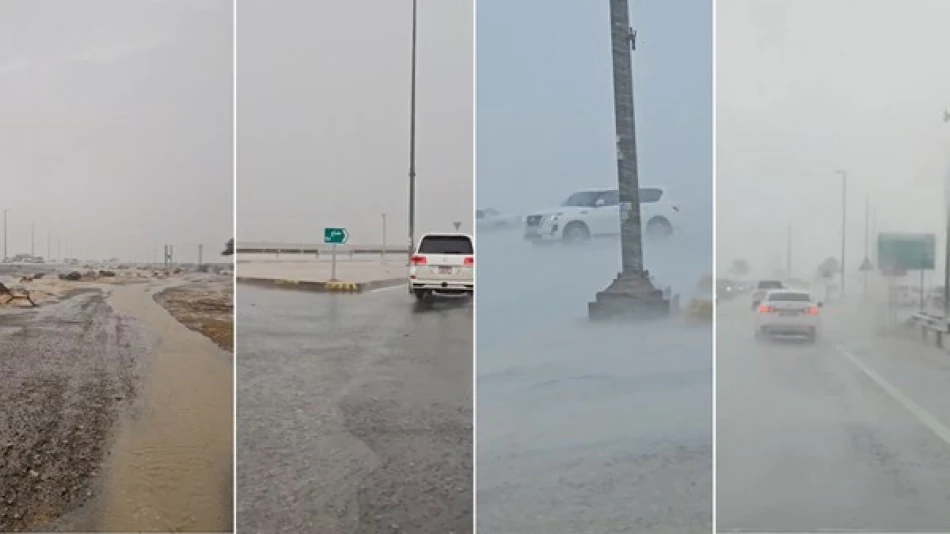
Heavy Rainfall Brings Relief to Al Ain City
UAE Braces for Extended Rainfall as Seasonal Weather Patterns Intensify
The United Arab Emirates is experiencing moderate to heavy rainfall across several regions, with the National Center of Meteorology warning residents to exercise extreme caution as unstable weather conditions are expected to persist through Friday. The current weather pattern, driven by the Indian seasonal low-pressure system, highlights the UAE's increasing susceptibility to dramatic weather shifts that can impact daily life and economic activity in the desert nation.
Al Ain Bears the Brunt of Current Rainfall
Al Ain city and its surrounding areas have been particularly affected by the current precipitation, with the National Center of Meteorology issuing specific warnings about heavy rainfall and strong downdrafts from cumulonimbus clouds affecting eastern regions. These conditions pose multiple hazards, including flying debris from strong winds, significantly reduced horizontal visibility, and dangerous water accumulation in low-lying areas.
The meteorological authority has specifically advised residents to avoid areas where water tends to collect, a crucial safety measure in a country where flash flooding can occur rapidly due to the desert terrain's limited absorption capacity.
Meteorological Forces Behind the Weather Pattern
Seasonal Low-Pressure Systems Drive Change
The current weather pattern stems from the extension of the Indian seasonal low-pressure system, combined with thermal depressions from the southwest. This meteorological combination creates a perfect storm for the region's characteristic summer weather volatility. The presence of the eastern mountains amplifies these effects, as rising daytime temperatures create the ideal conditions for cumulonimbus cloud formation.
A weak surface low-pressure system extending from the east, accompanied by an upper-level atmospheric depression, has created partially cloudy conditions that transition into more dramatic weather patterns, particularly during afternoon hours when thermal heating peaks.
Wind and Sea Conditions
Current wind patterns are generating dust storms with speeds reaching 40 kilometers per hour, creating additional visibility challenges for transportation and outdoor activities. Despite the atmospheric turbulence, both the Arabian Gulf and the Sea of Oman are experiencing relatively calm conditions with light wave activity, suggesting the weather system's impact remains primarily terrestrial.
Extended Forecast Through Friday
The National Center of Meteorology predicts a consistent pattern through the end of the week, with clear to partially cloudy conditions giving way to afternoon cumulonimbus cloud development in eastern and southern regions. Wind speeds are expected to remain variable, ranging from light to moderate (10-25 km/h) but intensifying to 40 km/h during peak daytime hours, continuing to stir dust and reduce visibility.
This extended timeline suggests residents and businesses should prepare for ongoing disruptions, particularly those in agriculture, construction, and outdoor services sectors that are most vulnerable to weather-related interruptions.
Implications for UAE's Desert Climate Adaptation
This weather event underscores the UAE's ongoing challenge of managing extreme weather variations in an arid environment. The country's rapid urban development and infrastructure expansion must continuously adapt to these seasonal patterns, which can shift from intense heat to sudden rainfall within hours.
For a nation that receives limited annual precipitation, these concentrated rainfall events are both beneficial for water resources and potentially disruptive to urban systems not designed for heavy water flow. The government's proactive weather monitoring and public warning systems demonstrate the sophisticated approach required to manage these natural challenges in a modern desert economy.
As climate patterns continue to intensify globally, the UAE's experience with managing extreme weather transitions offers valuable insights for other arid regions facing similar meteorological volatility.
Most Viewed News

 Layla Al Mansoori
Layla Al Mansoori






